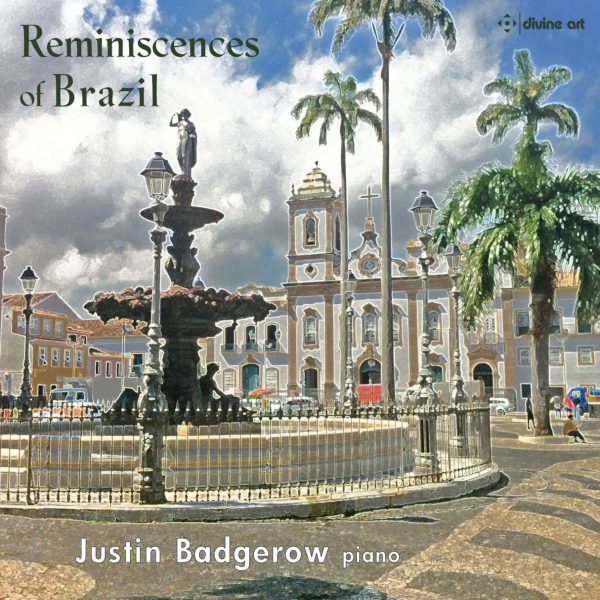The Arts Fuse
No two ways around it: Justin Badgerow’s Reminiscences of Brazil is a thoroughly appealing release. A survey of mostly 20th-century solo piano music from Brazil, the selections want nothing for stylistic diversity, melodic invention, and rhythmic verve. About half of the disc’s playtime is devoted to music by Heitor Villa-Lobos and Darius Milhaud.
Badgerow’s performances of four of the latter’s Saudades do Brasil – “Copacabana,” “Sorocaba,” “Sumare,” and “Ipanema” – run the gamut from dreamy to raucous. In Villa-Lobos’s Bachianas brasileira no. 4, Badgerow ably draws out the opening movement’s mighty climaxes but never at the expense of the musical line. The second, with its imitations of chiming bells, is beautifully structured. The pianist’s sense of pacing and balance of voicings is most impressive in the third movement Aria, while the final “Dança” is vigorously done.
Likewise striking is Badgerow’s take on two movements from Villa-Lobos’s evocative Ciclo Brasileiro.
The remainder of the program is devoted to music by Francisco Mignone, Paulo Gondim, and Mozart Camargo Guarnieri.
Mignone’s 1932 Seis Preludios are a welcome discovery, mixing as they do atmospheric gestures (in no. 1), taut rhythms (no. 2), stately lyricism (no. 4), and a condensed rhapsodic structure (no. 5). Similarly fetching are Mignone’s graceful Valse Élégante and pulsing Congada.
While the Villa-Lobos and Mignone pieces sometimes straddle the line between the worlds of high art and popular Brazilian musics a bit starkly, the Gondim works don’t. Gingado is spirited and ebullient. In the lush, lyrical Sonhando, the opening figure seems to channel Lerner and Loewe’s “Almost Like Being in Love.” Sapeca is a playful romp; Fim de tarde em Amargosa a flowing nocturne; and Teimosia proves spunky but elegant. So, in Badgerow’s hands, does Guarnieri’s lively Dansa Brasileira.
On the whole, then, these are stylish, sympathetic performances of ingratiating and engaging repertoire. Badgerow clearly has the measure of the music and a strong understanding of how to convey its subtleties: you’re in excellent hands here.
My only reservations about the disc owe to a combination of its engineering and the instrument Badgerow’s playing on. To put it simply, the piano sounds a bit distant and lacks a degree of tonal variety that would be particularly welcome between, say, the Villa-Lobos and Gondim selections. Of course, that may just be a personal bias and it shouldn’t put you off investigating what is a finely curated and played survey of some wonderful music.
@divineartrecordingsgroup
A First Inversion Company
Registered Office:
176-178 Pontefract Road, Cudworth, Barnsley S72 8BE
+44 1226 596703
Fort Worth, TX 76110
+1.682.233.4978










![Listen to the full suite of Marcel Dupré’s Variations Sur un Noël, Op. 20 from Alexander Ffinch’s #Expectations release today! listn.fm/expectations [in bio]](https://scontent-dfw5-1.cdninstagram.com/v/t51.71878-15/588904367_2327488161082898_8709236950834211856_n.jpg?stp=dst-jpg_e35_tt6&_nc_cat=105&ccb=7-5&_nc_sid=18de74&efg=eyJlZmdfdGFnIjoiQ0xJUFMuYmVzdF9pbWFnZV91cmxnZW4uQzMifQ%3D%3D&_nc_ohc=H8WFKm530VcQ7kNvwGfh5ZF&_nc_oc=AdkKrExvukPcWX7srO3AkxJdfygFmn1rsoKcZ0yw59UZi4JgF462GNrtm6he0RS_ngY&_nc_zt=23&_nc_ht=scontent-dfw5-1.cdninstagram.com&edm=ANo9K5cEAAAA&_nc_gid=UcuFGHLWBLCJf2p5cxPzvg&oh=00_AflMHgApXDqvwhM-bApdixbOpoB3V8lTl-diCUbz6pjXqA&oe=6954C06A)

![“the ‘Manteca’ Paraphrase – a rare foray into the two-piano medium but here played double-tracked – exudes a panache of which Dizzy Gillespie would surely have approved.… [a] recital well worth investigating.” —Gramophone Magazine with high praise for Ophelia Gordon's debut release, Kapustin: Between the Lines!](https://scontent-dfw5-3.cdninstagram.com/v/t51.82787-15/598796470_18303255136283342_540941604740887837_n.jpg?stp=dst-jpg_e35_tt6&_nc_cat=108&ccb=7-5&_nc_sid=18de74&efg=eyJlZmdfdGFnIjoiRkVFRC5iZXN0X2ltYWdlX3VybGdlbi5DMyJ9&_nc_ohc=IC4zZ7tcpb8Q7kNvwERLVTM&_nc_oc=Adl5x3Esme0kvrFSlKOezY2GH8NSqpj0B3EGhb0nFsz8ZT-p5hmmLIRK6u419CfQG6U&_nc_zt=23&_nc_ht=scontent-dfw5-3.cdninstagram.com&edm=ANo9K5cEAAAA&_nc_gid=UcuFGHLWBLCJf2p5cxPzvg&oh=00_AfkyjzH5jPPP3r3JIdsbxpMwPsq5iz6leTiBdCWk_XeQ0g&oe=6954D304)